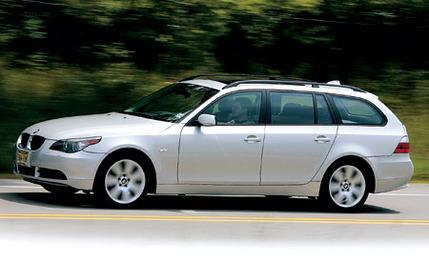
 Short Take Road Test
Short Take Road Test
SUV devotees always seem to have an explanation why a sedan or wagon isn't right for them. Popular rationalizations include a perceived need for an elevated seating position, a pumped-up image, or all-wheel drive.
For 2006, BMW neutralized that last excuse by adding its xDrive all-wheel-drive system-similar to that in the X3 and X5 sport-utes, defaulting to rear-wheel drive and delivering up to a 50/50 split via an electronically controlled clutch pack as conditions require-to create sedan models badged 525xi and 530xi. Also new, after a two-year hiatus, is a 5-series wagon, which only comes with all-wheel drive and the high-output 255-hp, 3.0-liter inline-six, making it a 530xi. BMW has declined to keep abreast of Mercedes by offering a V-8-powered wagon.
Not surprisingly, the 5-series acquired a couple SUV-like qualities in the wagon transformation: a higher roof (by 0.9 inch) and a big weight increase. BMW claims all-wheel drive adds roughly 170 pounds and the wagon body style puts on another 210, but our silver test car weighed in at a somewhat bloated 4145 pounds, 505 more than the last 530i sedan we tested.
The wagon's price is hefty, too, starting at $52,095, a $2400 increase over a 530xi sedan and $4600 more than a 530i. Our car came with an impoverishing $10,770 in options, including $1275 for a six-speed automatic, $1800 for an upgraded stereo, and the $2100 Premium package that adds leather seats and a power liftgate.
We also got the optional head-up display, showing vehicle speed as well as cruise-control and navigation info. But it costs $1000, its position on the windshield isn't adjustable as it is on GM vehicles, and you can only get it after coughing up $1800 for the navigation system.
Passenger space is excellent in the sedan and now in the similarly sized wagon. And the wagon's back seat is much more accommodating than the X5's, for example, despite the identical 45-cubic-foot rating. The 530xi has generous footroom under the front seats, and the backs of the front buckets have knee-friendly contours in them.
Unfortunately, BMW is furthering a perplexing trend of tying vehicle functions to the brake pedal. Even though there is a typical automatic-transmission lever, you must apply the brakes to start the vehicle and to shift out of park or, below 5 mph, to shift out of neutral-causing annoyance while trying to emerge from a carwash.
Once engaged, the six-speed shifts smoothly but prematurely in the name of fuel economy. EPA ratings are 20 mpg city and 27 highway, off just 1 and 2 mpg, respectively, from a rear-drive 530i. But we found ourselves flogging the wagon harder to compensate for the added bulk and ended up getting 19 mpg.
As expected, straight-line performance has worsened: 0-to-60 mph happens in 7.6 seconds and the quarter-mile in 15.9, compared with 6.9 and 15.3 seconds for a 530i (with the old 225-hp inline-six). However, our wagon bettered that 530i in grip (0.84 g versus 0.82) and braking (161 feet versus 176) due to optional 18-inch rubber.
There's no great mystery as to why we prefer wagons over SUVs. Here's how the 530xi wagon stacks up against a six-cylinder X5: It weighs 630 fewer pounds, scores better fuel economy, beats it to 60 mph by a half-second, stops from 70 mph to 0 in 11 fewer feet, has better grip around the skidpad, and hauls more cargo with the second-row seats in place.
So if you're serious about having sport with your utility, the chefs here at C/D will always recommend sampling the wagon.